Verbascum varieties: 16 amazing options for bright summer spires
Our favorite verbascum varieties to add vertical accents to borders and provide nectar for bees
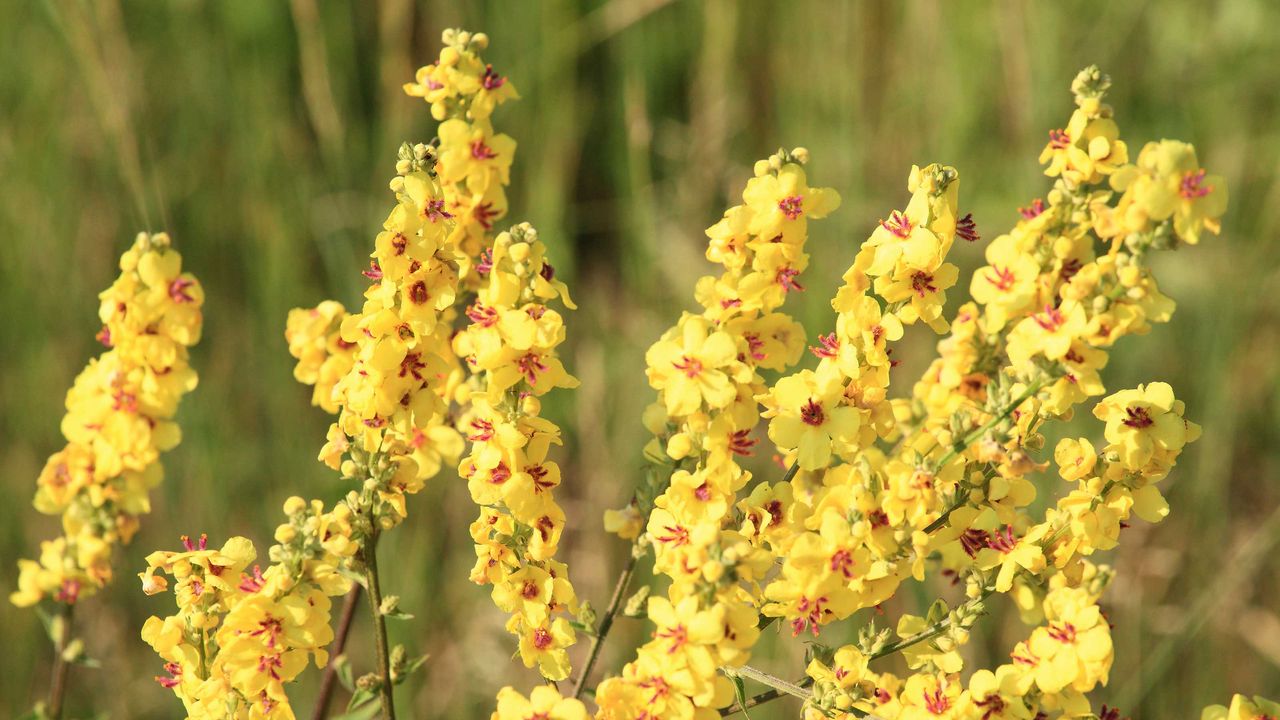
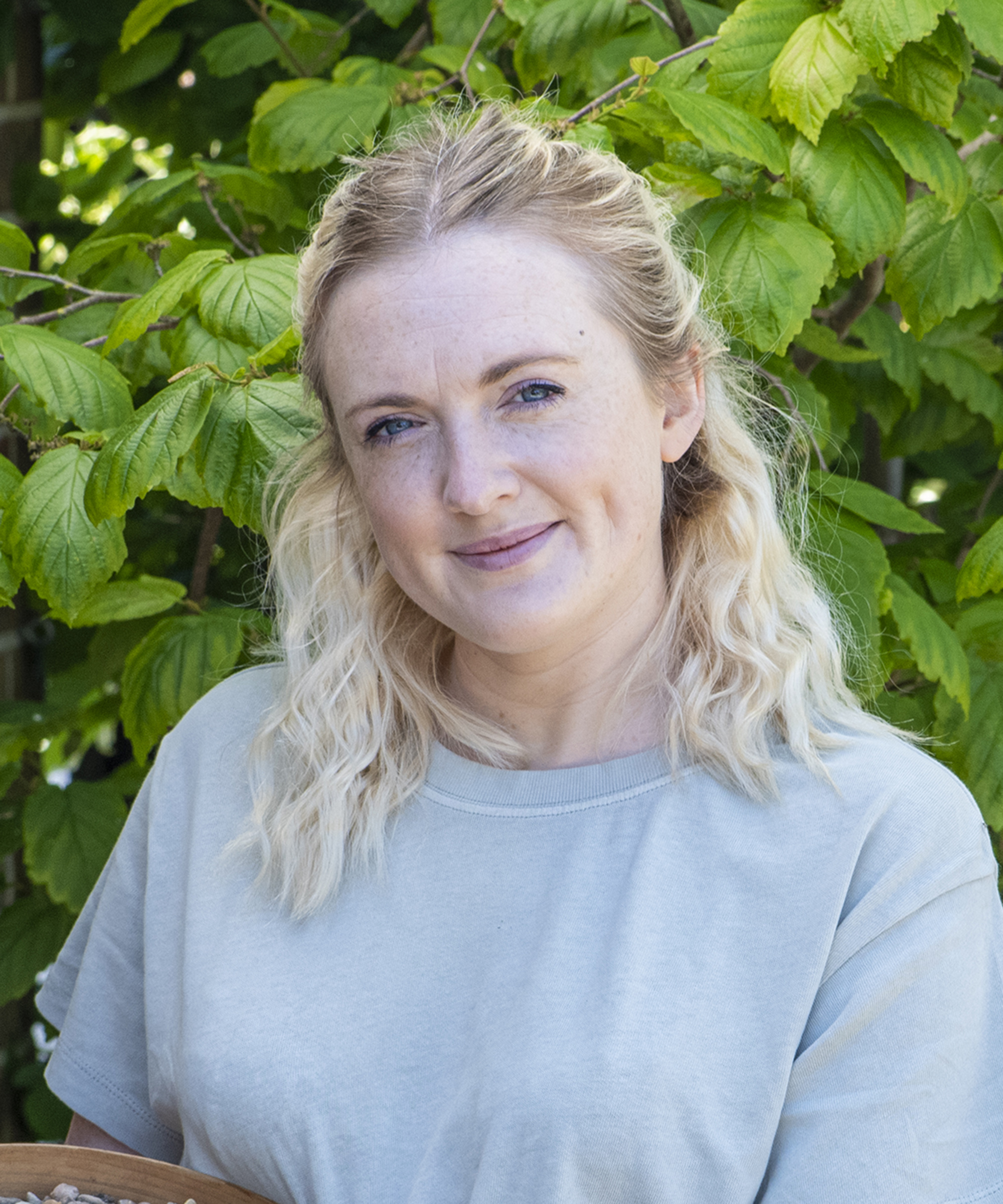
When verbascum varieties (mulleins) are at their best in summer, they form incredible spires of yellow, peach, pink, or white. Resembling huge candelabras of flowers, these architectural beauties produce vertical accents in the border. Anyone lucky enough to have visited the gardens of Beth Chatto, Great Dixter, or RHS Hyde Hall in the UK during summer will be familiar with these dazzling giants.
Although very tall, verbascums are slender and therefore are versatile additions to flower bed ideas as they don't obscure any plants behind. At Hyde Hall, they bloom close to the paths, amongst a sea of orange California poppies, as well as in the middle and at the back of borders, towering above other drought-tolerant plants.
These gorgeous giants seed themselves around the garden, making them very easy to grow in the right conditions. There are both biennial and perennial forms, although the perennial group of mulleins is not known for being long-lived. The likes of 'Helen Johnson' and 'Gainsborough' often only live for a year (three to four years at best), so they must be propagated regularly.
'We have Verbascum bombyciferum and V. olympicum in the Dry Garden,' says Ian Bull, Garden Manager at RHS Hyde Hall. 'Both have beautiful, large, gray basal leaves that are woolly and hairy and they throw up huge candle-like flowering spikes to 6ft tall, bearing golden-yellow flowers. They give wonderful height and vertical interest and the bright yellow flowers look fantastic against a clear blue sky.'
16 best verbascum varieties to grow for a stunning summertime show
There are lots of lovely types of verbascum to choose from. But whichever you go for, ensure you plant them in the right spot to help them thrive.
'Originating from Greece and Turkey, verbascum love an open, sunny site, so would be ideal for a south-facing garden,’ says Ian Bull.
'They dislike winter wet, so the soil must be free draining. They don't need any support, but if the soil is very fertile they may put on more growth and not support themselves so well, as they are used to growing in poor, dry, stony soil in Mediterranean gardens.'
1. Verbascum creticum (syn. 'Cotswold King')
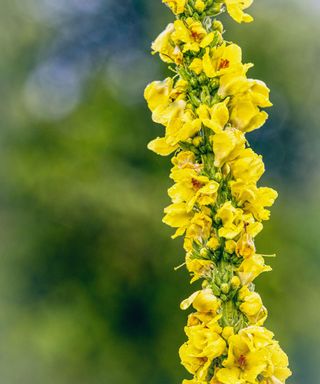
- Hardiness: USDA 4–9 (UK H7)
- Height: 3ft (90cm)
- Plant with: Cirsium rivulare 'Atropurpureum'
This is a fantastic self-seeding biennial verbascum that sends up spires of large (2in/5cm), fragrant gold flowers with a central dark bee, above green leaves.
This mullein is best in light, well-drained neutral to alkaline soil in full sun. Allow it to sow itself to get more free plants by leaving the spent seed heads on the plant after it has finished flowering.
2. Verbascum roripifolium
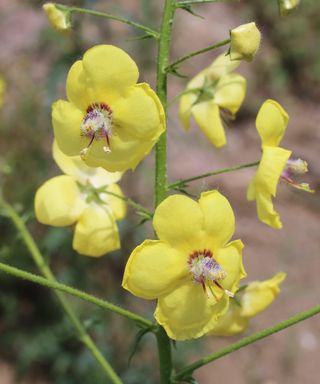
- Hardiness: USDA 4–9 (UK H7)
- Height: 3ft (90cm)
- Plant with: Stipa tenuissima
Unlike regular verbascums, which grow in dense spires, this unusual Greek biennial forms a lightweight, delicate cloud of lemon-yellow flowers on very thin stems.
Having a 'see-through' quality when it flowers in summer and fall, this airy verbascum is great for creating layers when grown amongst types of ornamental grasses. Let it self-sow in well-drained soil in sun or semi-shade.
3. 'Gainsborough' (Cotswold Group)
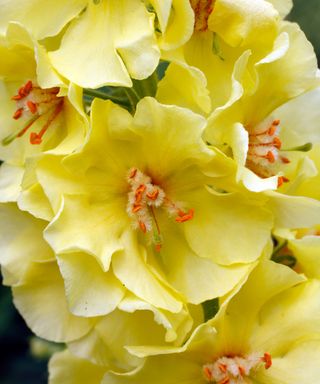
- Hardiness: USDA 5–9 (UK H6)
- Height: 3ft (90cm)
- Plant with: Allium amethystinum 'Red Mohican'
This perennial form carries candles of primrose yellow flowers above rosettes of gray-green leaves. Plant it in the middle of the summer border amongst other bee friendly plants.
This verbascum variety is sterile, so will not self-seed. In well-drained soil in sun, it will live for a few years before needing to be replaced. When it's time, buy new plants or propagate your own from root cuttings.
4. 'Jackie'
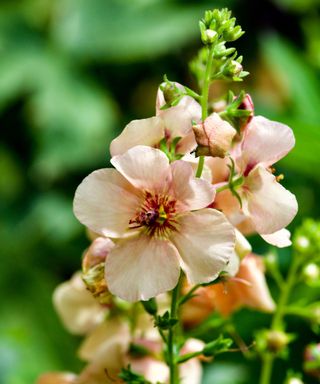
- Hardiness: USDA 5–9 (UK H6)
- Height: 2ft (60cm)
- Plant with: Aquilegia vulgaris var. stellata 'Ruby Port'
'Jackie' is a short, stylish, and compact mullein that has spires of peach-pink flowers in summer. It is a cross between V. dumulosum and V. phoeniceum and grown as a short-lived perennial plant.
Buy young plants that have been grown from root cuttings from a reputable supplier. Then, plant in well-drained soil in sun.
5. 'Helen Johnson'
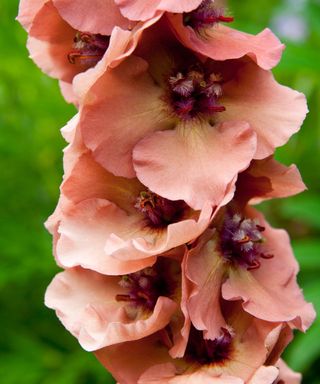
- Hardiness: USDA 5–9 (UK H6)
- Height: 2.5ft (75cm)
- Plant with: Anemanthele lessoniana
This is a gorgeous perennial form found at Royal Botanic Gardens Kew, producing attractive pink-copper flower spikes all summer above a rosette of wrinkly gray-green leaves.
A beautiful addition to modern and cottage garden schemes alike.
6. 'Clementine'
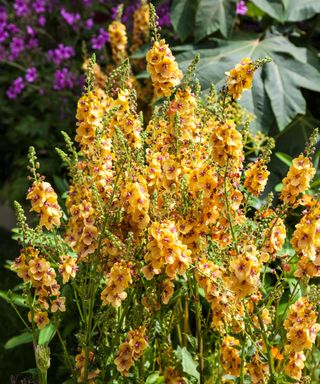
- Hardiness: USDA 5–9 (UK H6)
- Height: 5ft (1.5m)
- Plant with: Papaver somniferum 'Lauren's Grape'
'Clementine' is an orange form bred by former National Collection holders Claire Wilson and Vic Johnstone. The apricot flowers have purple bees and bloom on spikes above a rosette of leaves.
Said to be one of the more reliable perennial types of verbascum, it's a lovely pick to brighten up the back of a border.
7. 'Merlin'
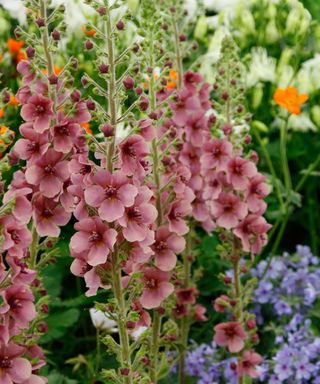
- Hardiness: USDA 5–9 (UK H6)
- Height: 3ft (90cm)
- Plant with: Achillea 'Credo'
'Merlin' is another of the more reliable perennial verbascum varieties, living up to three to five years before needing to be replaced. It has spires of dusky purple-pink flowers above rosettes of leaves in summer – perfect for a romantic planting scheme.
It does best in very well-drained, light, neutral to alkaline soil types in an open position in sun or semi-shade. After a few years, you can make new plants by taking root cuttings in early fall.
8. 'Southern Charm'
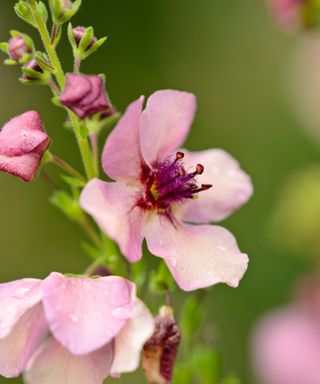
- Hardiness: USDA 5–9 (UK H6)
- Height: 3ft (90cm)
- Plant with: Centaurea cyanus 'Black Ball'
This is a lovely perennial mullein that sends up spikes of apricot-pink flowers with purple-pink centers above a rosette of hairy gray-green leaves. They make great cutting garden flowers for displaying in a vase.
A V. phoenicum and V. chaixii cross, 'Southern Charm' can be grown from seed and will sow itself in light, well-drained soil in sun. It can also be propagated via root cuttings.
9. 'Pink Domino' (Cotswold Group)
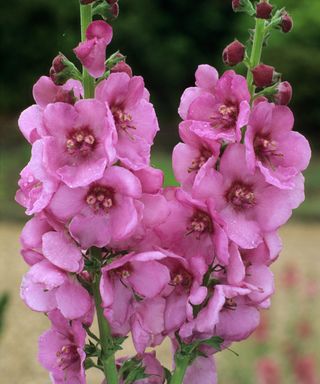
- Hardiness: USDA 5–9 (UK H6)
- Height: 4ft (1.2m)
- Plant with: Oenothera lindheimeri
Rich rose-pink flowers bloom on the upright, slender spikes of this mullein, above a rosette of wrinkled green leaves, during summer.
Ideal for creating vertical interest as a drought-tolerant plant in a dry garden or gravel border, this short-lived perennial verbascum enjoys very light, well-drained neutral to alkaline soil in sun.
10. Verbascum chaixii 'Album'
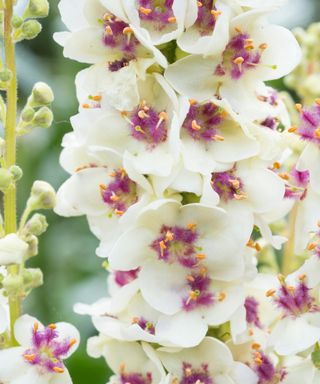
- Hardiness: USDA 5–9 (UK H6)
- Height: 3ft (90cm)
- Plant with: Lychnis coronaria
These nettle-leaved verbascum varieties produce upright candles of white flowers with purple bees, from rosettes of hairy gray leaves, in high summer.
They are easy to grow from seed, but are short-lived perennials that will only live for two to three years. Plant in well-drained, light soil in full sun. They will self-sow and may hybridize with other verbascum varieties.
11. Verbascum lychnitis
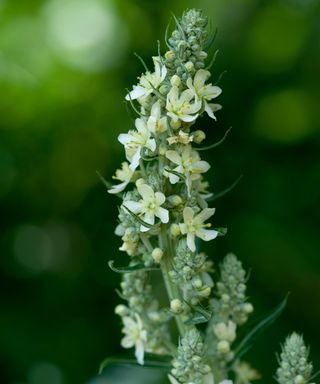
- Hardiness: USDA 5–9 (UK H6)
- Height: 3ft (90cm)
- Plant with: Verbena hastata
This mullein is native to Europe and has naturalized in parts of the US. In mid to late summer, it sends up branching spikes of white (or yellow) flowers, above gray-green leaves.
Grow this biennial in poor, very well-drained soil with plenty of elbow room in full sun. Avoid growing in the US, where it hybridizes with the very invasive plant V. thapsus and can spread.
12. Verbascum phoeniceum 'Flush of White'
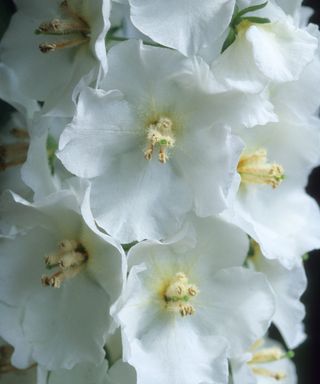
- Hardiness: USDA 5–9 (UK H6)
- Height: 30in (75cm)
- Plant with: Stachys byzantina
Spires of pure-white flowers adorn this biennial or short-lived perennial form in early summer, above a rosette of leaves, followed by attractive seed pods.
These elegant verbascum varieties can be grown from seed and may flower in their first year. They can also sow themselves around the garden, potentially hybridizing with other mulleins in the vicinity.
13. Verbascum olympicum
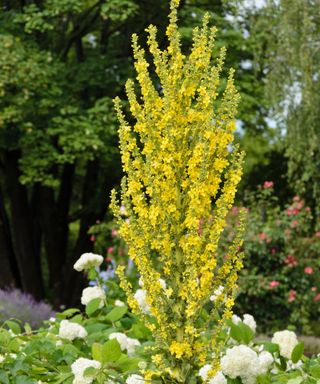
- Hardiness: USDA 5–9 (UK H6)
- Height: 7ft (2m)
- Plant with: Eschscholzia californica
This biennial's tall candelabras of lemon flowers are impressive at RHS Hyde Hall and Great Dixter. 'It can be used in groups or scattered throughout a border to add height and interest,' wrote Christopher Lloyd, who created the garden at Great Dixter. 'It will self-sow.'
It's best grown in very light soil in sun. Leave the seed heads for winter impact and to encourage self-sowing.
14. Verbascum phlomoides 'Spica'
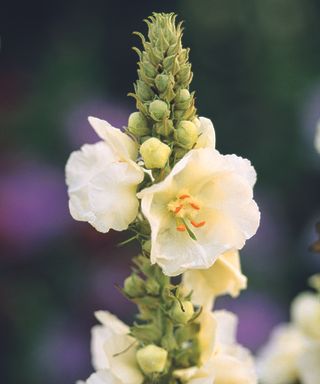
- Hardiness: USDA 5–9 (UK H6)
- Height: 6ft (1.8m)
- Plant with: Eryngium yuccifolium
The white form of the woolly mullein produces spikes of ivory flowers above rosettes of downy silver-green leaves, creating enchanting vertical accents in the border.
This is a great self-seeding biennial. Grow it in well-drained soil in full sun and leave the spent seed heads to add interest to the fall garden and allow it to self-sow.
15. Verbascum bombyciferum
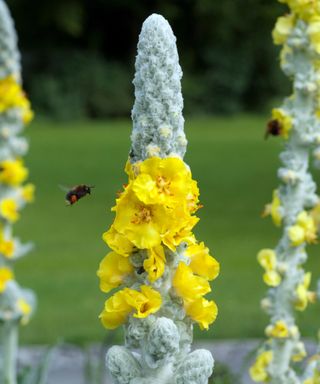
- Hardiness: USDA 5–9 (UK H6)
- Height: 7ft (2m)
- Plant with: Cynara cardunculus
One of the stars in Beth Chatto's Gravel Garden in the UK, Broussa mullein sends up towers of sulfur-yellow flowers amongst woolly silver foliage, above a wide rosette of leaves.
Another great plant for seed heads, allow this architectural biennial to self-sow by not cutting it back over winter. Thin the gray-leaved seedlings or move them to wherever you want them to grow.
16. 'Christo's Yellow Lightning'
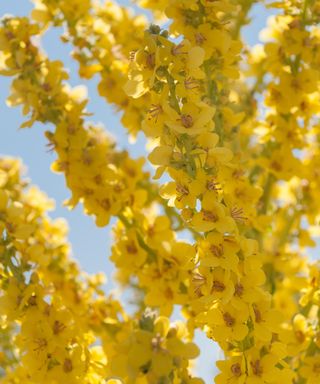
- Hardiness: USDA 5–9 (UK H6)
- Height: 5ft (1.5m)
- Plant with: Allium 'Summer Drummer'
Named after a donkey called Lightning that Christopher Lloyd came across in Turkey, this new short-lived perennial mullein from Great Dixter forms densely-packed branching spires of pale-yellow flowers above rosettes of gray-green leaves.
It's happiest in light, well-drained soil in full sun, with plenty of space around it. Plant with purple flowers, such as alliums, for a show-stopping display.
Which are the easiest verbascums to grow in your garden?
For an easy life, opt for the self-seeding biennial verbascum varieties (such as V. bombyciferum and V. olympicum) and avoid the sterile perennial forms. The self-sowing biennials reliably provide new plants, while the sterile perennials sometimes don't survive after being planted and, if they do, they must be propagated.
If you want the perennial forms, only buy very young plants from a reputable supplier and propagate them the following year by taking root cuttings.
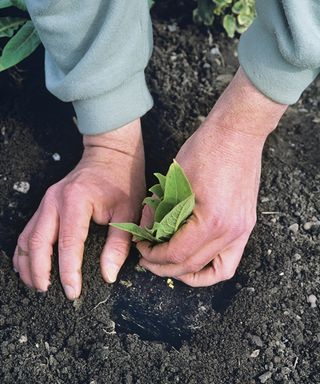
Verbascums planted in a sunny position will perform best
Do verbascums come back every year?
Some do. The excellent biennial forms (such as V. bombyciferum and V. olympicum) self-seed. Leave their architectural skeletal seed heads over fall and winter to ensure they sow themselves.
If planted when young, the perennial forms (such as 'Merlin') can live for two to five years.
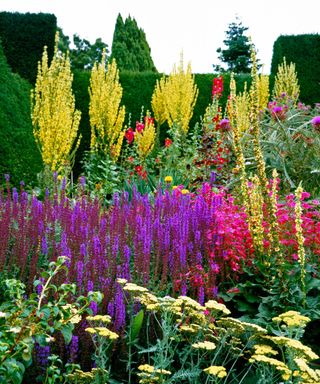
Biennial Verbascum olympicum reliably self-seed

Teresa has worked as an Editor on a number of gardening magazines for three years now. So she is lucky enough to see and write about gardening across all sizes, budgets and abilities. She recently moved into her first home and the garden is a real project! Currently she is relishing planning her own design and planting schemes. What she is most passionate about when it comes to gardening are the positive effects it has on our mental health to grow and care for plants, as well as being great for the environment too and help provide food and shelter for wildlife.
